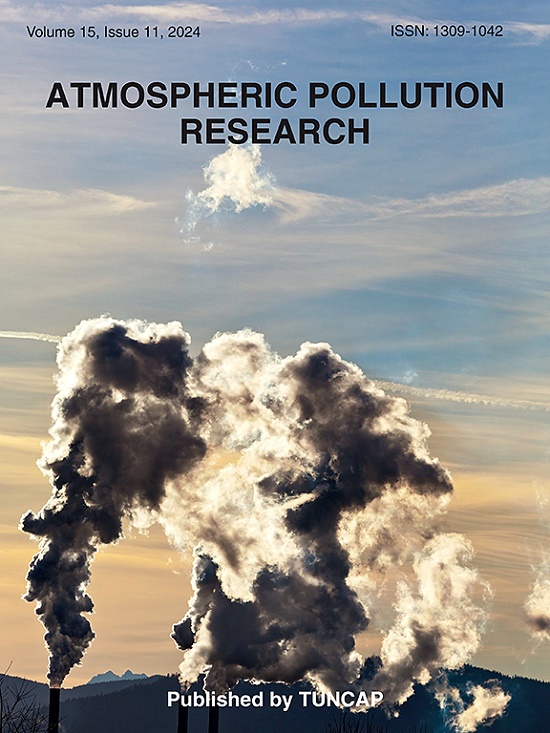PM2.5-bound PAHs in Chinese typical non-ferrous smelting area: appointment and risk assessment associated with specific industrial and biomass sources
IF 3.5
3区 环境科学与生态学
Q2 ENVIRONMENTAL SCIENCES
引用次数: 0
Abstract
The non-ferrous smelting industry (NSI) is a key source of atmospheric organic compounds, leading the serious impacts on the surrounding environment and the health of residents over industrial concentration areas. In this study, nine sampling sites were arranged in the NSI aggregation area for seasonal monitoring of PM2.5-bound PAHs. Our results revealed that total concentration of PM2.5-bound PAHs was 10.9 ± 4.70 ng/m3. These values reached 49.1 ng/m3 near the NSI, which were 2.8–4.2 times greater than the concentration of the background sample. Seasonal vary caused by sources and meteorology resulted in an average concentration in winter (16.2 ± 2.08 ng/m3) that was 2.6 times higher than that in summer. Based on appointment of specific sources, NSI sources account for 23.5 %–28.5 % of PAHs and biomass burning (BB) contributes significantly to PAHs, up to 28.9 % in spring. The long-range transportation of BB smoke in Southeast Asia is considered the major reason, combined with trajectories and fire spots. Risk assessment showed vehicle and NSI emissions accounted for over 71.1 % of the cancer risk from PM2.5-bound PAHs exposure. Residents have a higher cancer risk in winter, and the incremental lifetime carcinogenic risk values of adults around the NSI exceed the threshold value (10−6). The results indicate that residents living near NSI areas face higher health risks, and suggest controlling and managing PAHs emissions related to the NSI.

中国典型有色冶炼地区pm2.5结合的多环芳烃:特定工业和生物质来源的确定与风险评估
有色金属冶炼工业是大气中有机化合物的重要来源,对工业集中区周边环境和居民健康造成严重影响。本研究在NSI聚集区设置9个采样点,对pm2.5结合的多环芳烃进行季节性监测。结果显示,pm2.5结合的PAHs总浓度为10.9±4.70 ng/m3。这些值在NSI附近达到49.1 ng/m3,是背景样品浓度的2.8 ~ 4.2倍。由于来源和气象的季节变化,冬季的平均浓度(16.2±2.08 ng/m3)是夏季的2.6倍。根据具体源的指定,NSI源占多环芳烃的23.5% ~ 28.5%,生物质燃烧(BB)对多环芳烃的贡献显著,在春季高达28.9%。东南亚地区BB烟的远距离传播,结合轨迹和火点被认为是主要原因。风险评估显示,机动车和机动车尾气排放占pm2.5多环芳烃暴露致癌风险的71.1%以上。冬季居民患癌风险较高,NSI附近成人终生致癌风险增量值超过阈值(10−6)。结果表明,居住在NSI区域附近的居民面临更高的健康风险,建议控制和管理与NSI相关的多环芳烃排放。
本文章由计算机程序翻译,如有差异,请以英文原文为准。
求助全文
约1分钟内获得全文
求助全文
来源期刊

Atmospheric Pollution Research
ENVIRONMENTAL SCIENCES-
CiteScore
8.30
自引率
6.70%
发文量
256
审稿时长
36 days
期刊介绍:
Atmospheric Pollution Research (APR) is an international journal designed for the publication of articles on air pollution. Papers should present novel experimental results, theory and modeling of air pollution on local, regional, or global scales. Areas covered are research on inorganic, organic, and persistent organic air pollutants, air quality monitoring, air quality management, atmospheric dispersion and transport, air-surface (soil, water, and vegetation) exchange of pollutants, dry and wet deposition, indoor air quality, exposure assessment, health effects, satellite measurements, natural emissions, atmospheric chemistry, greenhouse gases, and effects on climate change.
 求助内容:
求助内容: 应助结果提醒方式:
应助结果提醒方式:


